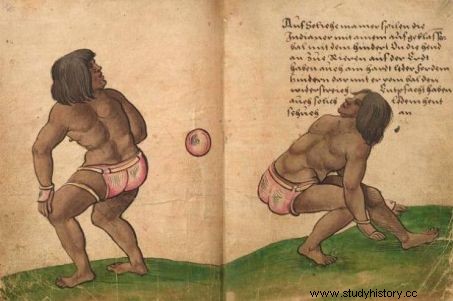The ball game is one of the most emblematic practices of Mesoamerican civilizations. It flourished there for more than 3000 years. One of its oldest lands was recently discovered in Mexico.

Bas-relief representing ball players found in the archaeological site of Tonina, in Chiapas (Mexico).
At 3,400 years old, the second oldest known ball court in America has been discovered at the site of Etlatongo, in the Highlands of the Nochixtlán Valley of Mixteca Alta, Mexico, as just reported by a study published by Jeffrey Blomster and Victor Salazar Chávez of George Washington University (USA), in Science Advances.
 Beneath the surface of this ancient playground, was discovered one of the oldest grounds of ball game, Mexico. © Etlatongo Project
Beneath the surface of this ancient playground, was discovered one of the oldest grounds of ball game, Mexico. © Etlatongo Project
Until now, most of these vestiges suggested that the initiators of this ritual game were the populations of the coastal settlements of the Lowlands of the southern Gulf of Mexico and the Pacific. Remember that the practice of this game played a big role in Mayan and later Aztec Mesoamerican societies, in this geographical area stretching over all of Central America, from northern Mexico to Costa Rica.
 These remains of figurines discovered at Etlatongo represent ball players. Their padded belts helped them hit the ball with their hips. © Blomster and Salazar Chavez.
These remains of figurines discovered at Etlatongo represent ball players. Their padded belts helped them hit the ball with their hips. © Blomster and Salazar Chavez.
It is by carrying out archaeological excavations on a vast ball game area built around 1200 BC. J.C, in Etlatongo, that the traces of a previous land of 1500m 2 have been discovered. Older, it could be dated to 1374 BC thanks to carbon 14. The presence of human remains, charred bones of animals and plants, as well as fragments of figurines of ceramic ball players, seems to testify of a surrender ceremony. Rituals which symbolically consisted in putting a place under the protection of ancestors, when it was put out of function.
 Players had to hit a rubber ball, without using hands, feet, or the head, as shown in this illustration from a colonial document. © Christoph Weiditz, Germanisches National Museum, Nuremberg.
Players had to hit a rubber ball, without using hands, feet, or the head, as shown in this illustration from a colonial document. © Christoph Weiditz, Germanisches National Museum, Nuremberg.
The ball game took place on a rectangular surface, a sort of large I-shaped alley about twenty meters long, bounded on both sides by a masonry platform. Two teams of two to seven players competed there. They had to send a rubber ball to each other, using their hips, elbows or forearms, shoulders or buttocks, without ever using their feet, hands or head. A spectacular game whose aim was - it seems - to pass the ball through a wall ring. But there was a darker side to it.
 Ring of the largest known ball court, that of the site of Chichen Itza, Mexico . © Shuterstock
Ring of the largest known ball court, that of the site of Chichen Itza, Mexico . © Shuterstock
The rich iconography found on the walls of Mayan sites such as Copan (Honduras) or Tonina (Mexico) clearly alludes to the human sacrifices that were practiced during these encounters (see box). Illustrating a cosmic drama, the rubber ball materialized the Sun, which by rising and falling during the game, symbolized its cycle, therefore the forces of life over those of death. The goal was to keep the star/ball moving for as long as possible.“ The wide variety of rubber balls ( up to 3 kg, and 8 to 30 cm Ed.) indicates a diversity of functions. Some may have been just offerings, burned like incense, while others were only used as part of the game “, explain the authors of the article.
To date, nearly 2,300 of these plots have been counted. The oldest known, dating from 1650 BC, is located in the plains of Chiapas, in Paso de la Amada. Currently, a modern variant of the pre-Hispanic ball game is in vogue in Mexico, under the name of ulama .
The ball game
Because of its association with human sacrifice and idolatrous religious practices, the ball game was banned by the Spanish after they conquered Mexico in 1519. on the writings of a Dominican friar named Diego Duran. Present in Mexico around 1570, he explained that a captive could be executed during an encounter. The other elements on these sacrificial aspects come from the Popol Vuh , a mythical Mayan epic. Recounted orally, a Dominican friar, Francisco Ximenez, would have subsequently transcribed it. It was about deities of the underworld confronting humans whom they beat by trickery, before decapitating them. The murdered heroes would then have faced these subterranean deities, would have emerged victorious, and then would have reserved the same punishment for them. Players sacrificed during games feature prominently in the iconography of many Mayan sites. However, a question remains, raised by certain specialists:do these themes of sacrifices illustrate the myth? Or were defeated players genuinely regularly sacrificed? The question is still debated.
